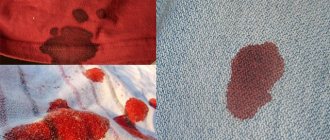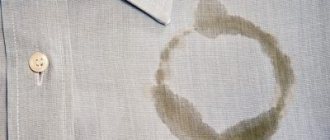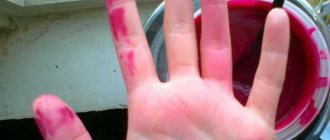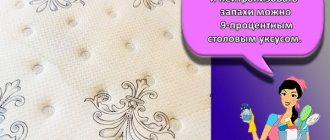Removing hard water stains is often easy. They can be removed from hard surfaces with a damp cloth, and from clothing with a cloth soaked in alcohol. In difficult cases, it is necessary to wash the item again, softening the water with soda, Calgon or another product. The worst way to remove dirt is from leather products - only wax impregnation will help here.
When choosing one or another method of dealing with stains, it is important to consider the type of material. It is better to get rid of contaminants immediately, before the salts eat in and damage the product irrevocably.
Hard water stains - what are they?
Hard water is water with a large amount of calcium and magnesium salts. When boiled, such water leaves a limescale deposit, harms hair and skin, and leaves stains on clothes and surfaces after wet cleaning.
Hardness is measured in milligram equivalents per 1 liter:
- at 4 mEq/L or less, water is considered soft;
- from 4 to 8 mEq/l – medium hardness;
- from 8 to 12 mEq/l – hard;
- over 12 mEq/l – especially hard.
The appearance of water stains is explained very simply: the liquid component evaporates, and hardness salts remain on the surface and look like spots with a white halo. In some cases, traces of water may be yellowish and gray. The shade indicates the presence of other impurities: rust, iron salts, oils and others.
If you washed an item for the first time, stains and drips may be a sign of poor quality paint. Unfortunately, it is impossible to restore the product in this case. Only re-painting will help save the situation. Or you can leave everything as it is and hope that over time the color will wash out evenly.
Wash and dry a second time
Whatever stain removal method you choose requires washing your car. This eliminates particles that could scratch the surface when trying to remove streaks.
You will need a clean bucket with warm soapy water, a second container of water for rinsing, a soft mitt or sponge, towels:
- Wash only when the car is cool.
- Spray the area with soapy water, then immediately rinse with clean water.
- If possible, hose down the body with water.
- Wipe off the water before it dries on its own.
For best results, try using distilled water, which does not contain minerals.
- Symptoms of midlife crisis in people
- Black Terrier - description, characteristics and breed standard, raising puppies, maintenance and diet
- Coronavirus prevention measures for older people
How to remove stains?
First of all, the volume of contamination should be taken into account. If hard water stains are large, bright and there are many of them, it is better to wash the product again. But this time you need to add baking soda or soda ash to the water (2 teaspoons or 1 teaspoon per 3 liters of water, respectively). When washing clothes in a washing machine, Calgon will help soften the water. Also, many modern powders contain softeners. With hard water, add more detergent, and then stains will not appear on clothes.
We recommend: How to properly clean copper coins using electrolysis?
With minor contamination, white spots can be removed point by point. The choice of method and means for cleaning the product should be made taking into account the type of material.
Most modern detergents do an excellent job of removing hard water stains. Alcohol, acids, and alkalis not only remove salts, but also prevent their appearance. As a rule, such contaminants appear if the product is washed only with water, without the use of chemicals, and drops of moisture are not wiped off.
From clothes
Fabrics most often come into contact with water and absorb all impurities from it. On light-colored matter, spots may be invisible, but on bright and dark matter they always catch the eye. The following tools will help you remove them:
- Lemon juice. Squeeze a teaspoon of lemon juice, soak a cotton swab and use quick circular movements to remove the stain. The method is excellent for cleaning jackets, down jackets, and Bologna clothes.
- Alcohol. Dilute medical alcohol 1 to 3 with water and wipe the stained area. You can use wet alcohol wipes.
- Saline solution. Dissolve 1 teaspoon of table salt in a glass of water. Wet the stain and then wipe with a dry cloth. The product cleans silk fabrics especially well.
- Iron and damp cloth. To remove hard water marks from fleecy fabrics (coats, sweaters), iron the contaminated surface with an iron through a wet cloth. Once dry, go over the area with a clothes brush.
From leather goods
To remove hard water stains from shoes or bags, you need to apply a cream or leather treatment to the surface. After waiting 20 minutes, the product needs to be polished with a flannel cloth. You can also use a special foam cleaner for leather, nubuck and suede. To prevent the appearance of such contaminants, products must be treated with impregnation that repels water, dust and dirt.
From the floor
Hard water stains that appear on laminate and other floor coverings can be removed by washing the floor with the addition of detergent. After this, you need to wipe the surface dry.
We recommend: Revealing the secrets of cleaning services - cleaning geometry, melamine sponges, steam for crevices
If the stain is single and has formed on the laminate, it can be easily removed using a silicone or wax-based polish. The area of contamination is rubbed and then polished.
From glass and tiles
Special window cleaning sprays work best with hard water stains. A regular microfiber cloth will also help remove dirt. You need to wet it slightly and wipe the glass or tile.
If no special means are found, use the folk recipe: add a tablespoon of ammonia to 200 ml of water and wipe off the dirt with a damp cloth. Use baking soda and a sponge to remove stubborn stains.
From furniture
Whitish stains on furniture can be removed in several ways. Wipe the product with the following means:
- flour and a damp cloth;
- sifted ash with the addition of 3-5 drops of vegetable oil;
- alcohol.
After cleaning, the surface must be polished with polish. Alternatively, you can rub the furniture with a napkin with a few drops of vegetable oil.
With car
Removing hard water stains from a car is quite difficult. It is better to prevent them from forming - after washing, immediately wipe the surface dry with a cloth. If the water does dry out, avoid using hard brushes and aggressive products. Dampen a soft cloth with the white vinegar solution and wipe down the vehicle without using any force. Rinse and then apply polish.
To reduce water hardness once and for all and prevent stains from appearing on your products, it is recommended to install a filter. It will retain salts and purify water from other harmful impurities.
Hard water stains are unsightly but can usually be removed quickly and easily. Use the above tools and methods according to the type of material. To prevent contaminants from reappearing, it is recommended to use water softeners or install a filter to remove hardness salts.
Basic ways to get rid
Depending on the type of fabric, you can remove white stains from the powder using one of the suggested products. Solutions can be prepared from ingredients available in the kitchen in a matter of minutes.
Laundry soap and vinegar
Pour 2-3 liters of water into a basin and add a couple of tablespoons of vinegar and a little grated laundry soap. The item is washed in the resulting solution.
If the smell of vinegar remains after washing, first rinse the clothes with conditioner and then in a large amount of water.
Fabric softener for colored laundry
The product is mixed with 1-2 liters of water, based on the manufacturer’s recommendations. The volume of liquid may vary depending on the size of the stains and the amount of clothing. The wash lasts 3-4 minutes, after which the items are removed from the solution and rinsed under running water.
See also
TOP 10 products for removing perfume stains from clothes at home
Citric and oxalic acid
Add 1 teaspoon of one or another substance to a small amount of warm water. Soak a cotton pad in the mixture and wipe the stain. Clothes are rinsed under running water.
Ammonia
An alcohol solution will help remove powder stains from items made from light-colored fabric. To prepare the mixture, add a teaspoon of ammonia to half a glass of water. Treat the dirty area with a slightly damp swab. If necessary, the procedure is repeated until the stains disappear.
Hydrogen peroxide
The available product is used not only for medical purposes, but also to solve many everyday problems. 2 parts hydrogen peroxide (3%) and 1 part detergent. The mixture is poured into a spray bottle. Processing plan:
- White stains are sprayed with spray.
- Rub the product in with a soft cloth or fingers.
- After 3-5 minutes, the item is washed again. You can’t leave peroxide on for longer: the fabric may become discolored.
Please note: before use, the solution must be tested on an inconspicuous area of the fabric. If used incorrectly, the concentrate can make the fabric several shades lighter.
Double rinse in the washing machine
You can remove stains by thoroughly rinsing. To do this you need:
- Pour powder or conditioner into the container.
- Turn on double rinse mode.
- Hang things on the dryer.
This is the simplest, but at the same time one of the most effective ways to get rid of traces of powder.
Boiling water
If the fabric is “not afraid” of high temperature, the item is placed in a basin and poured with boiling water. After half an hour of soaking, the clothes are removed and rinsed well.
Bleaches
A bleaching agent will help return your favorite blouse to its white color. Before use, you need to carefully study the product tag to make sure that the aggressive substance will not completely damage the item. Apply bleach only to blue stains. After processing is completed, the item is rinsed.
See also
Rules and best means to clean silicone sealant
What causes stains on the sofa?
In any room, despite the frequency and intensity of cleaning, dust accumulates on surfaces. Sofas and easy chairs are no exception.
Cleaning upholstered furniture more often is a rule of a good housewife.
And if you wipe the dust from the upholstery of such furniture without following certain rules, you can see whitish stains or the outlines of stains on the upholstery fabric.
Sometimes such a nuisance occurs due to insufficient removal of detergent from the surface. Sometimes stains remain after drying, especially if it contains a lot of salts.
Sometimes stains on sofas appear from food.
Most often, stains remain on the upholstery of upholstered furniture if the felt, foam rubber and padding polyester used to cover the sofa frames are excessively wet.










